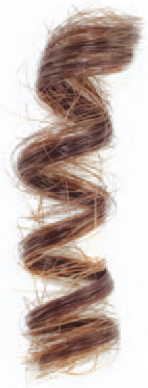






To guide you in caring for your curls, we recommend daily routines that are unique to each curl type: S’Wavy, Wavy, Cherub, Botticelli, Corkscrew, Corkicelli, Fractal.
Identify which characteristics best match your hair, then go to the daily routine for your curl type(s) to learn how to nurture and encourage your curls.
Note that throughout your curl journey, your specific curl type may evolve, especially as you become more consistent with your daily routine. This is because as you embrace healthy ingredients and tools, your hair will respond in ways that may surprise you.
The tightness of your curls (or spring factor) is one good way to determine which type of curly you are. The spring factor is the difference between the length of a curl when it falls naturally versus when it’s pulled down to its furthest point.
Here’s how to check yours: When your hair is fully dry, pull a strand of curls to its furthest point. Leave your finger at the point where the strand touches. Now let go. With a ruler, measure the distance between your finger and where your curl naturally ends. The measurement is your personal spring factor:
- 1 to 2-inch spring: S’wavy
- 2 to 4-inch spring: Wavy
- 5 to 10-inch spring: Cherub
- 5 to 8-inch spring: Botticelli
- 5 to 10-inch spring: Corkicelli
- 9 to 12-inch spring: Corkscrew
- 9 to 16-inch spring: Fractal or Zigzag
If you have short hair, your spring factor will be about half as long as the figures above.

oHair that appears straight in winter and s’wavy in summer.
oHair that has a tendency to look flat at the crown.
oLow to no frizz factor.
oA natural shine.
oA slight bend at the ends of your hair, depending on the length.
oHad straight hair when you were very young and s’wavy hair after puberty.
oA spring factor of 1 to 2 inches.
oDiscover the daily routine for S'Wavy Curls.

oHair that you’ve always believed was straight.
oHair that can appear straighter in the winter.
oHair that has a tendency to look flat on the crown.
oHair that occasionally develops a natural wave after coming out of the shower and at the beach.
oA slight frizz on humid days.
oHad straight hair when you were very young and wavy hair after puberty.
oA spring factor of 2 to 4 inches.
oDiscover the daily routine for Wavy Curls.

oBaby-fine hair that knots easily.
oDelicate curls that easily disperse in the wind, when moving around during sleep, or from too much touching or brushing.
oCurls that are weightless to the touch.
oA variety of curl lengths on your head.
oCurls that take a long time to grow and never seem to grow past a certain point.
oHair that appears longer or shorter depending on the weather and humidity.
oHad straight hair when you were very young and curly hair after puberty.
oA spring factor of 5 to 10 inches.
oDiscover the daily routine for Cherub Curls.

oCurls that vary in size and shape.
oA high frizz factor over the canopy if not hydrated properly.
oHermit curls underneath the nape that can shrink to half the length of those on the outside.
oA combination of curls that tend to be looser, in the shape of soft S’s, combined with those that are tight.
oCurls that have a spiral appearance.
oHair that seems to wilt if it gets too long. (This is because the weight of the top layer weighs the hair down.)
oCurls that are looser during winter and tighter during summer.
oHad straight hair when you were very young and curly hair after puberty.
oA spring factor of 5 to 8 inches.
oDiscover the daily routine for Botticelli Curls.

oConsistent corkscrew shaped spirals.
oA high frizz factor over the canopy if not hydrated properly.
oHair that appears thickly textured,, but is actually baby-fine and delicate to the touch.
oHair that breaks easily when combed or brushed.
oHair that soaks up as much conditioner as you feed it.
oTangles and knots under the nape of the neck.
oHair that appears longer or shorter depending on the weather and humidity.
oHad curls as a baby.
oA spring factor of 9 to 12 inches.
oDiscover the daily routine for Corkscrew Curls.

oVarying curl patterns throughout your hair’s overall landscape: for example, significantly tighter curls around the face and at the nape of the neck, while the rest of the hair is much looser, or vice versa.
oA higher frizz factor over the hair canopy if not hydrated properly.
oCurly hair throughout all seasons.
oHair that appears longer or shorter depending on the weather and humidity.
oHad loose curls as a baby and tighter curls after puberty.
oA spring factor of 5 to 10 inches.
oDiscover the daily routine for Corkicelli Curls.

oCurls from birth.
oCurls that appear identical and may be described as coils, micro-spirals, or fractal corkscrews.
oHair that is extremely dry.
oHair that’s hypersensitive to over-handling.
oCurls that don’t change with the season.
oA receding hairline from having your hair pulled back too tight, relaxed, or the weight of a weave. (All curly girls are prone to this, but fractal curls are more vulnerable.)
oA spring factor of 9 to 16 inches.
oDiscover the daily routine for Fractal Curls.